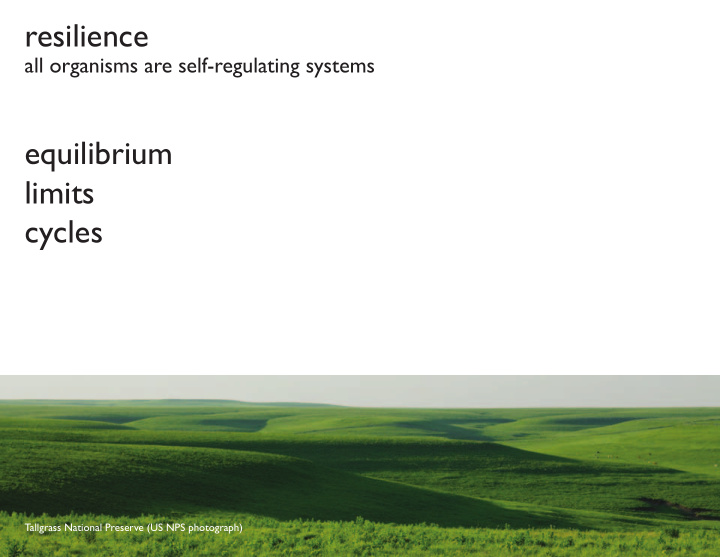



resilience all organisms are self-regulating systems equilibrium limits cycles Tallgrass National Preserve (US NPS photograph)
resilience the ability of a system to maintain its self-organizing capacity equilibrium from Ruddiman, Earth’s Climate Tallgrass National Preserve (US NPS photograph)
resilience the ability of a system to maintain its self-organizing capacity equilibrium This ball is at equilibrium. What happens if I push it? Tallgrass National Preserve (US NPS photograph)
resilience the ability of a system to maintain its self-organizing capacity equilibrium This ball is at equilibrium. What happens if I push it? Tallgrass National Preserve (US NPS photograph)
resilience the ability of a system to maintain its self-organizing capacity equilibrium This ball is stable only stability for small displacements. This ball is stable for larger displacements. It is more resilient. Tallgrass National Preserve (US NPS photograph)
resilience the ability of a system to maintain its self-organizing capacity equilibrium the shape of the curve may be related to how much the ball moves around Larger range of experience. Smaller range of experience. Less resilient than other ball. Tallgrass National Preserve (US NPS photograph)
resilience To what degree must the pairie change before it is no longer a prairie? Kansas (Flickr user powercat75) Tallgrass National Preserve (US NPS photograph)
resilience concepts Tallgrass National Preserve (US NPS photograph)
resilience concepts population depends on growth ( α) and mortality ( β) rates population Δ bunnies = α x bunnies - β x bunnies Δ time pioneer bunny time Tallgrass National Preserve (US NPS photograph)
resilience concepts population depends on growth ( α) and mortality ( β) rates population Δ bunnies = ( α − β) x bunnies Δ time slow initial growth time Tallgrass National Preserve (US NPS photograph)
resilience concepts population depends on growth ( α) and mortality ( β) rates population Δ bunnies = ( α − β) x bunnies rapid growth Δ time time Tallgrass National Preserve (US NPS photograph)
resilience concepts population growth, mortality, and competition γ population Δ bunnies = ( α − β) x bunnies rapid growth Δ time ( β + γ x bunnies) x bunnies time Tallgrass National Preserve (US NPS photograph)
resilience the ability of a system to maintain its self-organizing capacity equilibrium equilibrium growth, mortality, and competition population Δ bunnies = ( α − ( β + γ x bunnies) ) x bunnies Δ time time Tallgrass National Preserve (US NPS photograph)
resilience systems have many components inter-dependence bunny growth depends on daisies daisies = ( α x b x d) − (γ x b) Δ b population Δ t competition daisies pioneer bunny time Tallgrass National Preserve (US NPS photograph)
resilience systems have many components inter-dependence we need an equation for daisies daisies = ( α x b x d) − (γ x b) Δ b population Δ t Δ d = ( φ x d) − (δ x d x b) Δ t pioneer bunny time eaten by bunnies Tallgrass National Preserve (US NPS photograph)
resilience systems have many components inter-dependence bunny predation on daisies population Is this the end for daisies? time Tallgrass National Preserve (US NPS photograph)
resilience ecosystems are biological systems of inter-related components inter-dependence = ( α x b x d) − (γ x b) Δ b population Δ t Δ d = ( φ x d) − (δ x d x b) The bunny and daisy Δ t populations vary together. time Tallgrass National Preserve (US NPS photograph)
resilience all organisms exist within systems of inter-dependent organisms The bunny and daisy cycles populations vary together. population time Tallgrass National Preserve (US NPS photograph)
resilience all organisms exist within systems of inter-dependent organisms cycles organism characteristics number of organisms population (external forcings) time Tallgrass National Preserve (US NPS photograph)
resiliency The ability of a system to adjust its configuration and continue to function with disturbance. population time Tallgrass National Preserve (US NPS photograph)
Tallgrass Prairie National Preserve National Park Service U.S. Department of the Interior resilience Strong City, Kansas Vegetation Mapping Project Vegetation Classification Ta llgrass Prairie, Andropogon gerard ii (Sorghastrum nutans) Herbaceous A lliance, CEGL 2201 Rocky Mixed Prairie, Sch izachyrium scoparium – Bouteloua curtipendula – B. gracilis ecosystem Herbaceous Alliance, CEGL 2246 Bur Oak Woodland, Quercus macrocarpa, CEGL2053 Success ional Forest, Frax inus pennsylvanica inter-dependent biotic and abiotic – Ulmus americana – Celtis occidentalis Temporarily Flooded Forest Alliance, CEGL00218 components connected via Wet Ravine Vegetation, Spar tina pectinata Temporarily Flooded Herbaceous Alliance, CEGL 2223 processes that regulate the flow Brome Grass, Bromus inermis Sem i-Natural Herbaceous Alliance, CEGL005264 Restored Prairie of nutrients and energy through Weedy Ponds/Water Bodies the system Roadways ´ Cropfields Developed Land Boundaries Preserve Boundary Mapping Buffer Boundary 0 1 2 Miles
resilience To what degree must the pairie change before it is no longer a prairie? Kansas (Flickr user powercat75) Tallgrass National Preserve (US NPS photograph)
“There are no limits to the carrying capacity of Earth that are likely to bind any time in the forseeable future.” (Lawrence Summers, 1991) “Population blooms are always followed by crashes and die-offs. Always” (Heinberg, 2010) population time Tallgrass National Preserve (US NPS photograph)
Recommend
More recommend